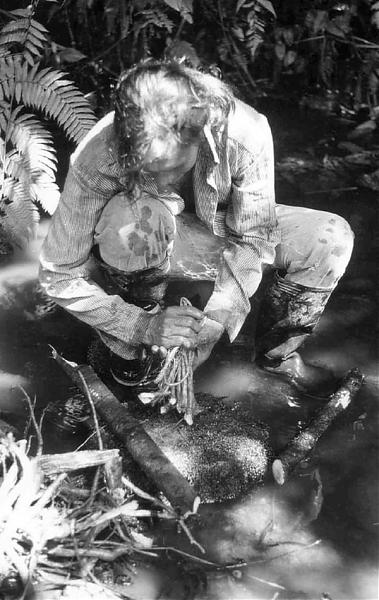Abstract
Among the indigenous group of the Shuar of the Nangaritza valley, research was undertaken on traditionally used wild and cultivated plants, their utilization and preparation, and their economic and cultural significance. The first results of the ethno-ecological/ ethno-botanical investigation carried out in 2002 in two Shuar communities, Chumbias and Napints, may be summarized as follows: The Shuar communities have a comprehensive environmental knowledge. They practice a land use system based on slash and burn horticulture, animal husbandry, as well as hunting and gathering - a system well adapted to the ecological environment of the lower tropical mountain forest. Plant gathering is essential for the Shuar subsistance economy and plays an important role within their material and spiritual culture. The actual inventory of traditionally used wild plants include 120 plant species. The majority of these plants are used for food (27%), construction material (23%) and medicine (16%). Food security of the Shuar depends mainly on cultivation in the forest and home gardens (chacras, huertas). The huertas contain highly diverse plant species and breeds. A total of 185 wild and cultivated plant species and breeds, used mainly for food (58%) and medicine (22%), were identified.
Resumen
Entre los grupos indígenas Shuar del valle de Nangaritza, se investiga el uso tradicional de plantas nativas y cultivadas; su preparación, utilización y significado económico y cultural. El primer resultado de la investigación ethno-ecológica/ ethno-botánica, se cumplió en el 2002 en las comunidades Shuar de Chumbias y Napints, de las cuales se resume lo siguiente: Las comunidades Shuar tienen un conocimiento amplio del medio ambiente. Sus prácticas y sistemas de uso de la tierra, se basan en cortar y quemar la horticultura, la cría, caza y recolección de animales - un sistema bien adaptado con el medio ambiente ecológico del bosque tropical montano bajo. La recolección de plantas es esencial para la subsistencia económica de los Shuar y juega un papel importante dentro de su cultura material y espiritual. El inventario actual del uso tradicional de plantas nativas incluye 120 especies de plantas. La mayoría de estas plantas son usadas para la comida (27%), material de construcción (23%) y medicina (16%). La seguridad alimentaria de los Shuar depende principalmente del cultivo en el bosque y en las huertas familiares (chacras, huertas). Las huertas contienen una gran diversidad de especies y clases de plantas. Un total de 185 especies y clases de plantas nativas y cultivadas fueron identificadas. El uso principal es para comida (58%) y medicina (22%).
Introduction
Given their location between the Andean highlands and the lowlands of the Amazon, the tropical mountain forests of the eastern Andean foothills in southern Ecuador have a proportionally rich biodiversity. The area under study, the region of the Parque Nacional Podocarpus (see (Figure 1), is especially noteworthy for its biodiversity and represents a so called "hotspot" (see Barthlott et al., 1996). The tropical mounain forests are most important as biological habitat, water reservoire and for the preservation of genetical resources. At the same time, these sensitive ecosystems are vulnerable because of the extraction of timber, mining activities, the extension of agricultural land and similar intrusions. According to Hamilton et al. (1995) 90% of the natural forest cover of the Andes are regarded as destroyed or at least modified by men.
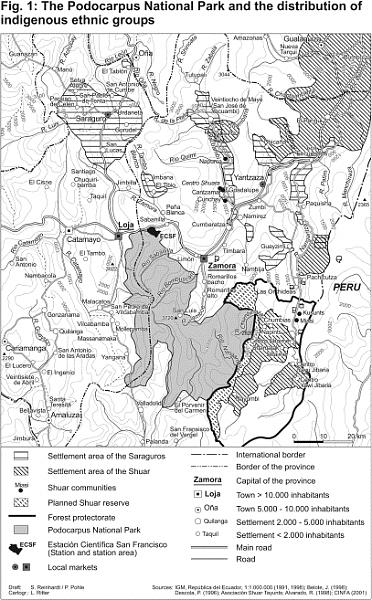
Figure 1. The
Podocarpus National Park and the distribution of indigenous. ethnic
groups.
Figura 1. El Parque
Nacional Podocarpus y la distribucion de grupos indigenas.
The indigenous ethnic group of
the Shuar
The settlement area of the indigenous group of the Shuar stretches from the lower reaches of the tropical mountain forests to the lowlands of the Amazon in the border area with Peru (see (Figure 1). Besides the practice of slash and burn horticulture, the Shuar fish, hunt and gather forest products. Recently some Shuar families have also begun to raise livestock. Although the traditional way of life of the Shuar has changed because of external influences such as missionaries, settlers and mining activities, they were able to preserve, until recently, most of their traditional culture, including their extensive knowledge of plants and their utilization.
Results and Discussion
In July and August 2002 in two Shuar communities, Chumbias and Napints of the Nangaritza valley (see (Figure 1), research was undertaken on traditionally used wild and cultivated plants, their utilization and preparation, and their economic and cultural significance. Applying the ethno-ecological/ ethno-botanical approach, the following work was carried out:
documentation of ethno-specific knowledge about the ecosystem "lower tropical mountain forest", especially of the natural forest resources, including the use of forest products such as food, fodder, medicine, dyeing agents, construction material and fire wood;
inventory of traditionally used plants (wild and cultivated), including their botanical, indigenous Shuar and Spanish names;
agro-geographical analysis of the land use system, with special consideration of traditional forest gardening;
evaluation of traditional environmental knowledge, practices of land use and forest resource management for the preservation of biological and cultural diversity.
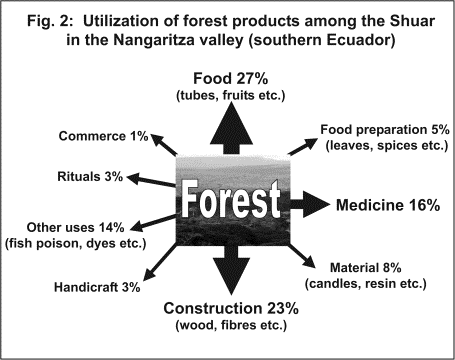
Figure 2 Use of
forest products among the Shuar in the Nangaritza valley (southern
Ecuador).
Figura 2. Uso de
productos forestales entre los Shuar del Valle de Nangaritza (Sur de
Ecuador).
The importance of forest
products for daily subsistance
The ethnoecological investigations, started in 2002 in the Nangaritza valley, have shown that the Shuar have a comprehensive knowledge of plants and their utilization. All 13 households of Chumbias and Napints make extensive use of forest products. According to first results of the ethnobotanical survey, the actual inventory of traditionally used wild plants includes 120 wild plant species. The majority of these plants are used for food (27%) and as construction material (23%, see (Figure 2), [[Table 1]]). Because there is no access to a formal health care system, medicinal plants (16%) are of great imortance as well (see [[Table 1]]). Many forest plants also have a significant cultural and spiritual value, e.g. in myths and rituals. Nearly all forest products are used for daily subsistance - there is virtually no commercialisation. The absence of economic power to buy food or medicine and the lack of direct access to markets because of very limited infrastructure are the main reasons that forests provide an important "safety net" for the livelihood of the Shuar in the Nangaritza valley.
Table. 1. Selected wild plants and their utilization among the Shuar in Chumbias and Napints (Nangaritza valley).
Tabla 1. Plantas silvestres seleccionadas y su uso entre los Shuar en Chumbias y Napints (Valle de Nangaritza).
| Wild plant species for food | ||||||
| Scientific name | Family |
Shuar name |
Spanish name | Life form | Part used | Utilization |
| Anthurium breviscapum | Araceae | Eép | Col del monte | Climber | Leaves | Leavy vegetable |
|
Anthurium
gigantheum Engl. |
Araceae | Chinumas | / | Climber | Leaves | Leavy vegetable |
| Anthurium section xialophyllium | Araceae | Wee eep | Col del monte | Climber | Leaves | Leavy vegetable |
| Anthurium triphyllum | Araceae | Eep guangat | Col de montaña | Climber | Leaves | Leavy vegetable |
| Bactris sp. | Arecaceae | Uwí yusa | Chonta duro | Palm | Palmhearts, fruit pulp | Vegetable, beverage (Chicha) |
| Inga edulis Mart. | Mimosaceae | Guampa, "Wampa" | Guaba | Tree | Fruit pulp | Raw fruit |
| Inga nobilis Willd. | Mimosaceae | Imiuk Sampi | Guabilla | Tree | Fruit pulp | Raw fruit |
|
Mauritia
flexuosa |
Arecaceae | Achu | Morete | Palm | Palm hearts, fruit pulp | Vegetable |
| Oenocarpus bataua | Arecaceae | Kunkuk, Kunkuki | Palma real | Palm | Palm hearts | Vegetable |
| Passiflora pergrandis Holm-Niels. & Lawesson | Passifloraceae | Guashimunshi | Granadilla | Climber | Fruit pulp | Raw fruit |
| Persea americana | Lauraceae | Iniak | Avocado silvestre | Tree | Fruit pulp | Raw fruit |
| Physalis peruviana L. | Solanaceae | Yuranmis |
Uva |
Shrub | Fruit | Raw fruit |
|
Pourouma
cecropiifolia Mart. |
Cecropiaceae | Shuinia | Uva de monte | Tree | Fruit | Raw fruit |
| Pouteria durlandii (standl.) Baehni | Sapotaceae | Yaas | Couje | Tree | Fruit | Raw fruit |
| Pseudolmedia laevigata | Moraceae | Chimi | Capuli | Tree | Fruit | Raw fruit |
| Rhodospatha latifolia Poeppig | Araceae | Kakirpas, Katirpas | Col del monte | Climber | Leaves | Leavy vegetable |
| Wild plant species for construction | ||||||
| Scientific name | Family |
Shuar name |
Spanish name | Life form | Part used | Utilization |
| Aegiphila sp. | Verbenaceae | Yumpink | / | Tree | Trunk |
House
construction |
| Casearia sp. | Flacourtiaceae | Makaer, Makaet | Cedrilla, Cedrillo | Tree | Trunk |
Furniture |
| Cedrelinga sp. | Fabaceae | Tseek | Shekui, Ceiki | Tree | Trunk |
Furniture |
| Erythrina peruviana Krukoff | Fabaceae | Etse | Porotillo | Shrub | Branches | Fences |
|
Heliconia
sp. |
Musaceae | Tumba | Platanillo | Shrub | Leaves |
Roof
construction |
| Inga nobilis Willd. | Mimosaceae | Samik | / | Tree | Trunk |
House
construction, furniture |
| Mauritia flexuosa | Arecaceae | Achu | Morete | Palm | Leaves | Roof construction |
| Oenocarpus bataua | Arecaceae | Kunkuk, Kunkuki | Palma real | Palm | Leaves | Roof construction, baskets |
|
Rhodospatha
sp. |
Araceae | Tingishapnek | / | Climber | Stems | Baskets |
| Rollinia sp. |
Annonaceae |
Junkua,
Yunkua, Yaisha |
/ | Tree | Bark | Cords |
| Socratea exorrhiza | Arecaceae | Kupat | Palma rallador | Palm | Trunk | House construction, furniture |
| Trema micrantha (L.) Blume |
Ulmaceae |
Kaaka | Sapan | Tree | Bark | Cords |
|
Wettinia
maynensis |
Arecaceae | Teren |
Chonta
pambil |
Palm | Trunk, leaves | House / roof construction, furniture |
| Wild plant species for medicine | |||||||
| Scientific name | Family |
Shuar name |
Spanish name | Life form | Part used |
Preparation |
Use in traditional medicine |
| Costus sp. | Costaceae | Undundu, Churunch | Caña agria | Shrub | Sap of stem | Oral application | Diarrhoea, fever |
| Croton lechleri Muell. Arg. | Euphorbiaceae | Urushmas | Sangre de drago | Tree | Sap of bark | Tincture | Remedy for wounds |
| Ficus cf. gomelleira Kunth | Moraceae | Wampu | / | Tree | Sap of bark | Oral application | Diarrhoea, amoebiasis |
| Hyptis pectinata (L.) Poit. | Lamiaceae | Wishu | Corta sangre | Herb | Sap of plant | Tincture | Remedy for wounds |
| Mansoa sp. | Bignoniaceae | Kaip | Ajo silvestre | Climber | Leaves | Infusion | Strengthening of the immune systeme |
| Physalis peruviana L. | Solanaceae | Yuranmis | Uva | Shrub | Fruit | Consumption of the fruit | Influenza |
| Picramnia sellowii Planch. | Simaroubaceae | Yamakai | / | Tree | Leaves | Compress of stamped leaves | Remedy for wounds |
|
Piper
cuspidiscum Trel. |
Piperaceae | Tintikip | / | Shrub | Leaves | Bath, nose douche | Fever, headaches |
| Piper sp. | Piperaceae | Uchi Ampara | / | Shrub | Sap of stem | Oral application | Diarrhoea of children |
| Piper stileferum Yunck | Piperaceae | Nampich ampar | / | Herb | Sap of roots | Oral application | Diarrhoea, intestine parasites, stomach-ache |
| Solanum americanum Mill. | Solanaceae | Shimpishi, Shimpiship | Mortin, Mortiño | Shrub | Leaves | Compress of stamped leaves, infusion | Influenza |
| Uncaria tomentosa (Willd. Ex Roem. & Schult.) Dc. | Rubiaceae |
|
Una de gato | Climber | Bark, stem, roots | Infusion | Strengthening of the immune systeme, stomach-ache |
| Wild plant species for material | ||||||
| Scientific name | Family |
Shuar name |
Spanish name | Life form | Part used | Utilization |
| Ficus sp. | Moraceae | Kamush | Matapalo | Tree | Sap of bark | Candle |
| Hevea brasiliensis (Willd. ex A. Juss.) | Euphorbiaceae |
|
Caucho | Tree | Sap of bark | Candle |
| Mauria sp. | Anacardiaceae | Kupa | / | Tree | Resin | Candle |
| Oenocarpus bataua | Arecaceae | Kunkuk, Kunkuki | Palma real, Ungurahua | Palm | Fruit pulp | Oil |
| Wild plant species for food preparation | ||||||
| Scientific name | Family |
Shuar name |
Spanish name | Life form | Part used | Utilization |
| Anthurium breviscapum | Araceae | Eép | Col del monte | Climber | Leaves | Spice |
| Anthurium section xialophyllium | Araceae | Wee eep | Col del monte | Climber | Leaves | Spice |
| Piper umbellatum L. | Piperaceae | Natsamar | Mariapanga, Santa Maria | Herb | Leaves | Spice, Maitos or Tonga (sh.) a done method |
| Renealmia alpina | Zingiberaceae | Kumpia | Tapioka | Shrub | Leaves | Maitos or Tonga (sh.) a done method |
| Wild plant species with cultural and religious significance | |||||||
| Scientific name | Family |
Shuar name |
Spanish name | Life form | Part used | Preparation | Traditional use |
| Banisteriopsis caapi | Malphigiaceae | Naatema | Ayahuasca | Climber | Woody stem parts | Infusion | Schamanistic cleaning ritual |
| Brunfelsia grandiflora D. Don | Solanaceae | Chirikiasa | / | Shrub | Stem | Additional plant for the Ayahuasca infusion | |
|
Dacryodes
peruviana |
Burseraceae | Kunchai | Copal | Tree | Resin | Smoke through burning | Smoke agains „mal aire" |
| Inga nobilis Willd. | Mimosaceae | Samik | / | Tree | Leaves | Frond of leaves | Schamanistic cleaning ritual |
| Piper umbellatum L. | Piperaceae | Natsamar | Mariapanga, Santa Maria | Herb | Leaves | Frond of leaves | Fragrance against „mal aire" |
| Wild plant species for handicraft | ||||||
| Scientific name | Family |
Shuar name |
Spanish name | Life form | Part used | Utilization |
| Canna edulis | Cannaceae | Waimpiak | Achira | Shrub | Seeds | Necklaces |
| Coix lacryma-jobi | Poaceae | / | Kariokria, San Pedro, Pepas de rosario | Grass | Seeds | Necklaces |
| Cayaponia capitata | Cucurbitaceae | Waak | Maní cunian | Climber | Seeds | Necklaces |
| Erythrina peruviana Krukoff | Fabaceae | Etse | Porotillo | Tree | Seeds | Necklaces |
| Wild plant species for other uses | ||||||
| Scientific name | Family |
Shuar name |
Spanish name | Life form | Part used | Utilization |
| Albizia sp. | Mimosaceae | Sekemur | / | Tree | Roots | Cleaning of hair and clothing |
| Alchornea glandulosa Poepp. & Endl. |
Euphorbiaceae |
Kantsa | / | Tree |
Fruits |
Birdseeds |
| Anthurium rubinervium (Link) G. Don | Araceae | Shiniumas eep | Col del monte | Climber | Leaves | Stimulant for dogs |
| Caladium bicolor (Aiton) Vent. | Araceae | Ushu | / | Shrub | Sap of roots | Veterinary medicine against skin parasites |
| Clibadium sp. |
Asteraceae |
Masu | Barbasco | Shrub | Leaves | Fish poison |
| Cyclanthera sp. | Cucurbitaceae | Takur | Lustre, Taco | Climber | Fruit | Sponge for cleaning |
| Genipa americana L. | Rubiaceae | Sua | Sula, Huituc (qu.) | Tree | Fruit | Dye for hair |
| Lonchocarpus CF. araripensis Benth. | Fabaceae | Inchitimo | Barbasco | Climber | Sap of roots | Fish poison |
| Lonchocarpus nicou | Fabaceae | Timiu | Barbasco | Climber | Sap of roots | Fish poison |
| Miconia calvescens Dc. | Melastomataceae | Chinchak | / | Tree | Fruits | Birdseeds |
| Picramnia sellowii Planch. | Simaroubaceae | Yamakai | / | Tree | Leaves | Stimulant for dogs |
Agrobiodiversity of the
traditional forest and home gardens (huertas)
Food security of the Shuar depends mainly on cultivation in the forest and home gardens (chacras, huertas), supplemented by the gathering of forest products. The huertas - mainly cultivated by women - contain highly diverse plant species and breeds. In five huertas that have been examined (each approximately 600-1000 m² large), a total of 185 wild and cultivated plant species and breeds, used mainly for food (58%) and medicine (22%), were identified. The main crops are starchy roots and tubers such as Manihot esculenta (Euphorbiaceae) and Colocasia esculenta (Araceae) as well as plantain breeds (Musa sp., see (Figure 3).
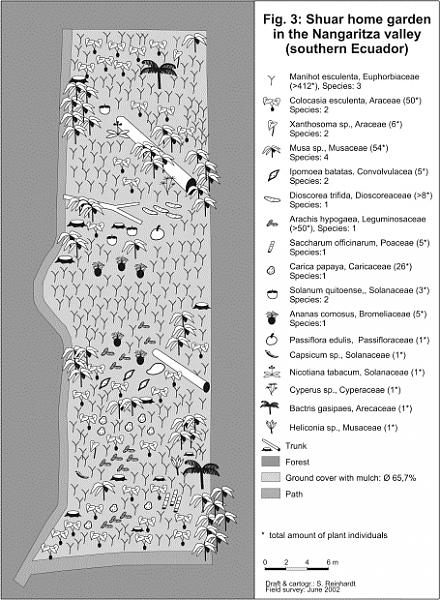
Figure 3. Shuar
home garden in the Nangaritza valley (southern Ecuador).
Figura 3. Jardin
Shuara en el valle de Nangaritza (Sur de Ecuador).
The huertas are of great significance for the in-situ conservation of genetic plant resources. A plurality of traditional breeds, for instance 29 breeds of Manihot esculenta and 21 breeds of Musa sp., can be found in the huertas of the Shuar. One has to bear in mind, though, that the diversity of species varies widely between individual family huertas. Huertas that are cultivated by young women who settled in the Nangaritza valley recently clearly show a lower diversity (less than 20 species) than those that are cultivated by older women whose families settled more than 20 years ago in the valley (ca. 60 species).
In spite of the wide spectrum of plants that are known to the Shuar, such as fruit or leafy green vegetables from the forest, the alimentation of the Shuar is relatively narrow and restricted to starchy roots and tubers in combination with albuminous animal products. Consequently, the comprehensive plant knowledge of the Shuar is not reflected in their alimentation.
Conservation through
utilization" - a new approach in sustainable forest
management
The traditional land use system of the Shuar which serve to maintain biodiversity may be contrasted with the forms of land use employed in the wake of recent agrarian colonization which are destructive of mountain forests. Large tracts of such forests are being irreversibly damaged and destroyed by slash and burn activities followed by pasturing on a vast scale. Lumbering, mining, oil production and the development of infrastructure is increasing pressure on the sensitive forest ecosystems. One of the last remaining enclosed virgin forest areas of southern Ecuador was placed under strict protection with the establishment of Podocarpus National Park, containing almost 150,000 hectares. Additionally three protected forest areas (Bosque Protector Colambo-Yacuri, Corazón de Oro and Alto Nangaritza) have been established recently. Disparities between the economic claims of the local population and what is called for under the protective measures, however, often represent a serious problem, one which may hinder the successful management of the conservation area.
Experience shows that sustainable management of biodiversity must both fulfil the aims of nature conservation and satisfy claims of utilization by the local population. Therefore, in addition to strict protection of the forests, a concept for "conservation through utilization" is desirable. The scheduled three year research project presented here is based upon this idea. Specifically, the research project stems from the hypothesis that the many-sided economic and cultural interests indigenous and local communities have in the forest would be the most effective way to protect the forest from destruction. Thus the analysis and assessment of ethno-specific knowledge about the tropical mountain forest and its utilization play a key role in this study. On the basis of the documentation of autochthon knowledge about the use and processing of wild and cultivated plants, the ethnobotanical inventory, and analysis of traditional land use systems, we will survey the extent to which existing indigenous knowledge about natural forest resources can be made available for a sustainable resource management.
Acknowledgements
The article is based on information given by: Vicente Florencio Sanchim Antun, Maria Silvia Chiriap Inchit, Inchit Euselbia Sanchim Chiriap, Chinin Enrique Chuinda Tsukanka, Cruz Alfonso Sanchim Chiriap, Antonio Augustin Yankur Yanua, Kintianua Rosa Tiwiram, Angel Montilio Yankur, Rosa Esperanza Narankas, Rosa Maria Wilagomes, Alipio Tentets, Mario Chuinda, Juan Chuinda (communities of Chumbias and Napints).
The project is committed to abide by the "Code of Ethics". The intellectual property rights and traditional resource rights and thus the data collected by the project are property of the indigenous and local communities. A commercial use of the collected data is not intended.
References
Barthlott, W.; W. Lauer; & A. Placke. 1996. Global distribution of species diversity in vascular plants: towards a world map of phytodiversity. Erdkunde, 50(4):317-327.
Bejár, E.; R.W. Bussmann; C. Roa & D. Sharon. 2002. Medicinal Herbs of Southern Ecuador - Hierbas Medicinales del Sur Ecuatoriano. San Diego.
Bennett, B.C.; M.A. Baker & P.G. Andrade. 2002. Ethnobotany of the Shuar of Eastern Ecuador. The New York Botanical Garden, New York.
Eyden, van den, V.; E. Cueva & O. Cabrera. (in press). Of 'climbing peanuts' and 'dog's testicles', Mestizo and Shuar plant nomenclature in Ecuador. Journal of Ethnobiology.
Hamiltin, L.; J. Juvik & F. Scatena. 1995. The Puerto Rico tropical cloud forest symposium: Introduction and workshop synthesis. Ecological Studies, 110:1-19.
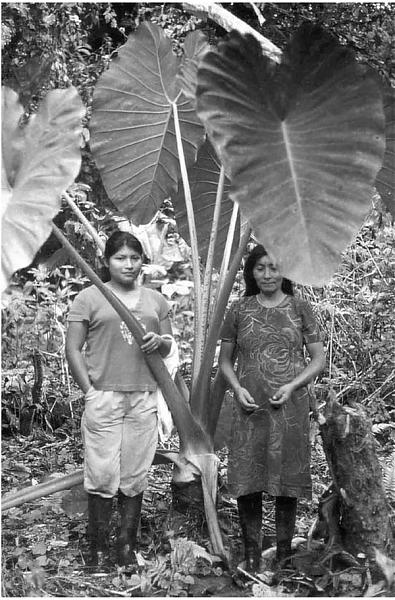
Photo 1. Shuar women
in their home garden with Xanthosoma sp. (Araceae).
Foto
1. Mujeres Shuar en su jardin con Xanthosoma sp. (Araceae).
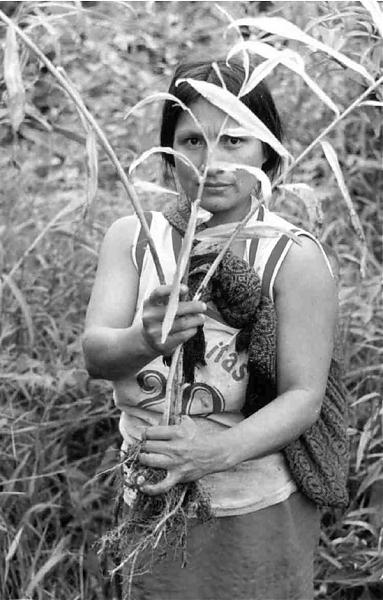
Photo 2. Shuar woman
showing the medicinal plant "Ajeje" (Zingiber sp.).
Foto
2. Mujeres Shuar monstrando la planta medicinal "Ajeje"
(Zingiber sp.).
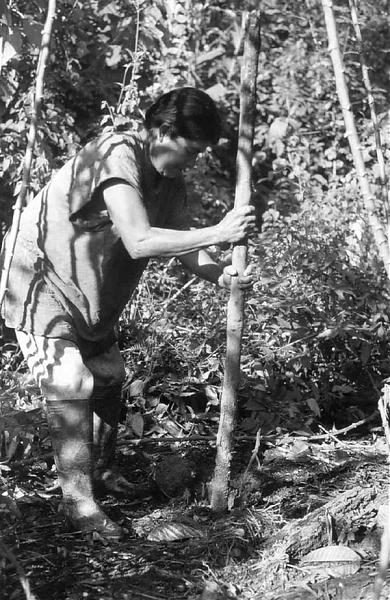
Photo 3. Planting of
Manihot esculenta (Euphorbiaceae).
Foto
3. Siembra de Manihot esculenta (Euphorbiaceae).
